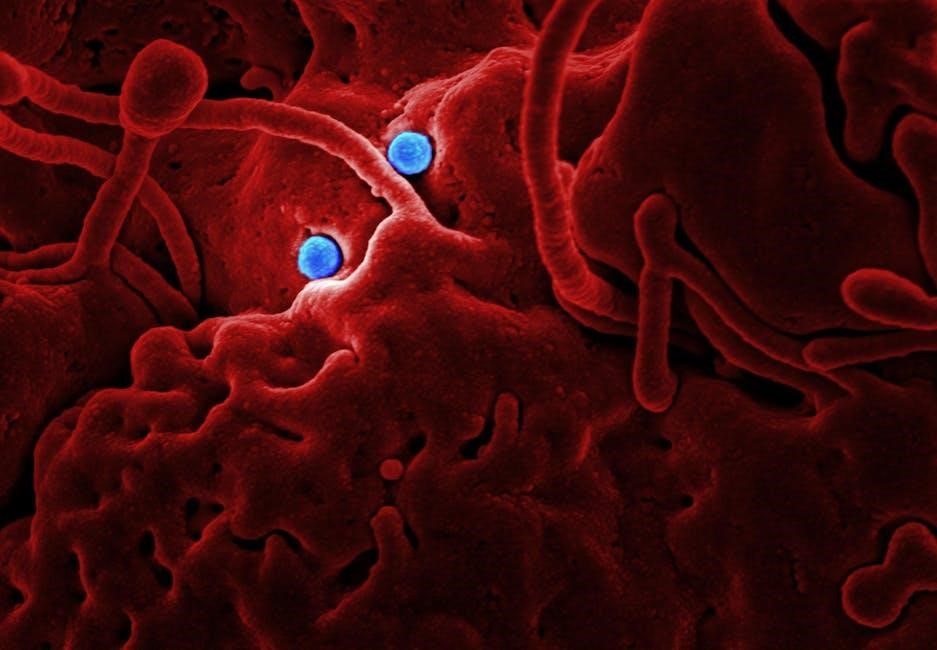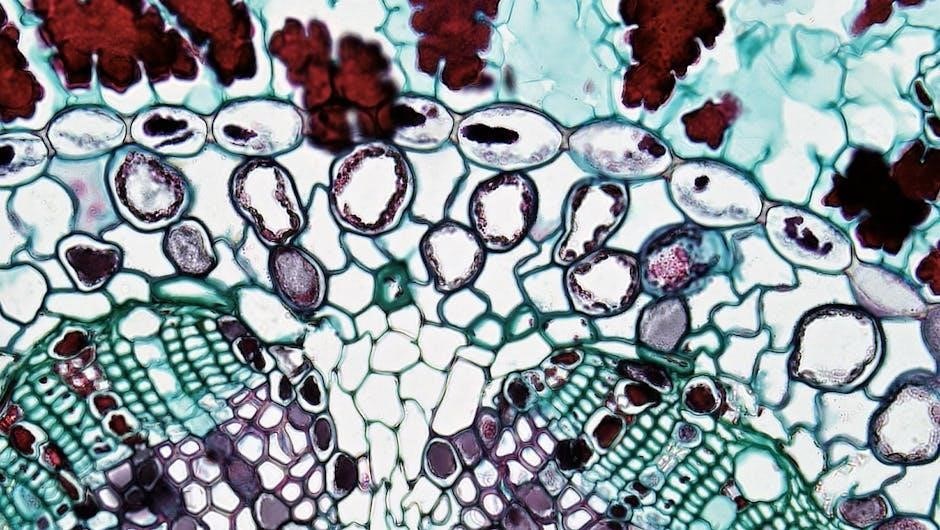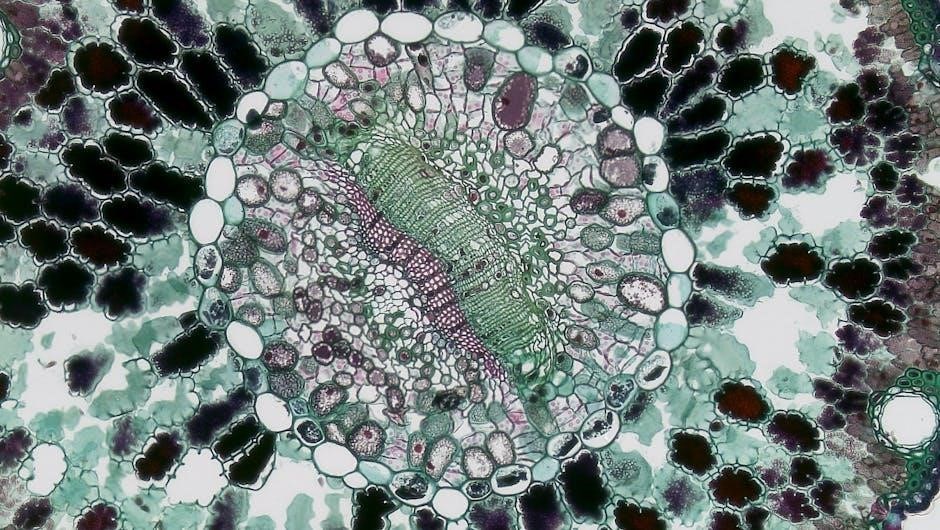Cellular respiration is a vital metabolic process converting glucose into energy (ATP) through aerobic and anaerobic pathways. Worksheets with answers simplify learning this complex mechanism for students.
What is Cellular Respiration?
Cellular respiration is a metabolic process where cells break down glucose and other organic molecules to produce energy in the form of ATP (adenosine triphosphate). This process occurs in all living organisms and is essential for life. It involves a series of chemical reactions that release energy from food sources‚ which is then stored in ATP molecules. Cellular respiration can occur with or without oxygen‚ known as aerobic and anaerobic respiration‚ respectively. Aerobic respiration is more efficient and produces a significant amount of ATP‚ while anaerobic respiration produces less energy and is typically a backup mechanism. The process is divided into stages‚ including glycolysis‚ the Krebs cycle‚ and the electron transport chain‚ each playing a critical role in energy production. Understanding cellular respiration is fundamental for studying biology‚ as it explains how cells generate the energy needed for various functions.
Importance of Cellular Respiration in Living Organisms
Cellular respiration is crucial for sustaining life as it provides the primary energy currency‚ ATP‚ essential for cellular functions. It powers muscle contractions‚ nerve impulses‚ and biosynthesis‚ enabling organisms to grow‚ reproduce‚ and respond to stimuli. Without cellular respiration‚ cells cannot maintain homeostasis or support metabolic activities. Additionally‚ it connects ecosystems by converting organic matter into carbon dioxide‚ linking life processes across trophic levels. Efficient cellular respiration ensures optimal energy utilization‚ vital for survival in diverse environments. Worksheets with answers help students grasp this fundamental concept‚ reinforcing its role in biology and ecological balance.

Key Stages of Cellular Respiration
Cellular respiration involves three main stages: glycolysis‚ the Krebs cycle‚ and the electron transport chain. These processes convert glucose into ATP‚ essential for cellular energy production.
Glycolysis: The First Stage
Glycolysis is the initial stage of cellular respiration‚ occurring in the cytoplasm. It breaks down glucose into two pyruvate molecules‚ producing a small amount of ATP and NADH. This process is anaerobic‚ meaning it does not require oxygen. The steps involve a series of enzyme-catalyzed reactions‚ starting with glucose and ending with pyruvate. Glycolysis is universal‚ occurring in both aerobic and anaerobic conditions. Worksheets often include diagrams and questions about the glycolytic pathway‚ emphasizing the conversion of glucose into energy and the preparation of molecules for subsequent stages. Understanding glycolysis is fundamental for grasping cellular energy production mechanisms.
Krebs Cycle (Citric Acid Cycle)
The Krebs Cycle‚ or Citric Acid Cycle‚ is the second stage of cellular respiration‚ occurring in the mitochondrial matrix. It begins with acetyl-CoA‚ derived from glycolysis‚ and produces ATP‚ NADH‚ and FADH2. This cycle involves a series of enzyme-catalyzed reactions that break down acetyl-CoA into carbon dioxide while generating energy-rich molecules. The Krebs Cycle is a critical step in aerobic respiration‚ linking glycolysis to the electron transport chain. Worksheets often include questions about the intermediates‚ energy yield‚ and the role of coenzymes like NAD+ and FAD. Understanding the Krebs Cycle is essential for comprehending how cells efficiently produce energy from glucose.
Electron Transport Chain and Oxidative Phosphorylation

The Electron Transport Chain (ETC) and oxidative phosphorylation are the final stages of cellular respiration‚ occurring in the mitochondrial inner membrane. The ETC transports electrons from NADH and FADH2 to oxygen‚ creating a proton gradient. This gradient drives ATP synthase to produce ATP through oxidative phosphorylation. Worksheets often include questions on the ETC’s structure‚ the role of proton pumps‚ and the ATP yield. Understanding this process is crucial for mastering cellular energy production‚ as it generates the majority of ATP during aerobic respiration. Practice questions help reinforce how the ETC and oxidative phosphorylation work together to efficiently produce energy for the cell.

Aerobic vs. Anaerobic Respiration
Aerobic respiration uses oxygen‚ producing more ATP‚ while anaerobic respiration occurs without oxygen‚ yielding less ATP. Worksheets compare their processes‚ energy outputs‚ and biological significance.
Aerobic Respiration: Processes and ATP Production
Aerobic respiration involves three main stages: glycolysis‚ the Krebs cycle‚ and the electron transport chain. Glycolysis occurs in the cytoplasm‚ breaking glucose into pyruvate‚ producing 2 ATP. The Krebs cycle takes place in the mitochondria‚ converting pyruvate into acetyl-CoA‚ generating 2 ATP. The electron transport chain produces the majority of ATP (32-34) through oxidative phosphorylation. Oxygen acts as the final electron acceptor‚ enabling the process. Total ATP per glucose is 36-38. Worksheets often detail these steps‚ emphasizing ATP yields and oxygen’s role. Understanding these processes is crucial for mastering cellular energy production.
Anaerobic Respiration: Mechanisms and Energy Yield
Anaerobic respiration occurs without oxygen‚ producing less ATP than aerobic respiration. It involves two main pathways: alcoholic fermentation and lactic acid fermentation. Alcoholic fermentation converts pyruvate into ethanol and carbon dioxide‚ yielding 2 ATP per glucose. Lactic acid fermentation produces lactate‚ also yielding 2 ATP. These processes are vital for organisms in low-oxygen environments. Worksheets often compare these mechanisms‚ highlighting their differences and energy outputs. Understanding anaerobic respiration’s role in muscle cells during intense exercise is essential. This section focuses solely on anaerobic processes‚ providing a clear distinction from aerobic respiration and their significance in energy production.
Comparing Aerobic and Anaerobic Respiration
Aerobic and anaerobic respiration differ in oxygen requirements and energy production. Aerobic respiration requires oxygen‚ yielding 36-38 ATP per glucose‚ while anaerobic respiration occurs without oxygen‚ producing only 2 ATP. Aerobic respiration involves glycolysis‚ the Krebs cycle‚ and the electron transport chain‚ ending with carbon dioxide and water. Anaerobic respiration includes glycolysis followed by fermentation‚ producing ethanol and carbon dioxide or lactic acid. Aerobic respiration is more efficient and occurs in mitochondria‚ while anaerobic respiration happens in the cytosol. Worksheets often include tables to compare these processes‚ highlighting their mechanisms‚ energy yields‚ and byproducts. Understanding these differences is crucial for grasping cellular energy production.

Cellular Respiration Worksheet Questions
Explore multiple-choice‚ true/false‚ fill-in-the-blank‚ and short-answer questions to test understanding of cellular respiration processes and energy production. These exercises cover glycolysis‚ Krebs cycle‚ and ATP synthesis.
- Multiple-choice questions on aerobic vs. anaerobic respiration.
- True/false statements about ATP production and electron transport.
- Fill-in-the-blank exercises on metabolic pathways.
- Short-answer questions for detailed explanations.
- The number of ATP molecules produced from one glucose molecule during aerobic respiration.
- The by-products of anaerobic respiration in muscle cells versus yeast cells.
- The location of glycolysis‚ the Krebs cycle‚ and the electron transport chain within the cell.
- Distinguishing between substrates‚ enzymes‚ and coenzymes involved in the process.
- True or False: Aerobic respiration produces 38 ATP molecules per glucose molecule.
- True or False: Oxygen is required for anaerobic respiration.
- True or False: Glycolysis occurs in the mitochondria.
- True or False: Lactic acid fermentation occurs in muscle cells.
- The first stage of cellular respiration‚ which occurs in the cytoplasm‚ is called __________.
- The molecule that carries electrons during the electron transport chain is __________.
- The byproduct of anaerobic respiration in muscle cells is __________.
- The process that produces the most ATP molecules per glucose is __________ respiration.
- Describe the main differences between aerobic and anaerobic respiration in terms of ATP production and byproducts.
- Explain the role of the Krebs cycle in cellular respiration and where it takes place within the cell.
- What is the significance of the electron transport chain in generating ATP during oxidative phosphorylation?
- Compare and contrast the outcomes of glycolysis under aerobic versus anaerobic conditions.
Multiple Choice Questions
Test your understanding of cellular respiration with multiple-choice questions designed to assess knowledge of key concepts. These questions cover various aspects of aerobic and anaerobic respiration‚ including:
Each question is crafted to reinforce fundamental principles and prepare students for advanced topics in cellular metabolism.
True or False Statements
Engage with true or false statements to evaluate your grasp of cellular respiration concepts. These exercises focus on critical facts‚ such as:
Each statement is designed to test comprehension of processes‚ locations‚ and outcomes. Understanding the rationale behind each answer enhances retention and clarifies misconceptions about cellular energy production.

Fill-in-the-Blank Exercises
Fill-in-the-blank exercises are an effective way to reinforce key terms and concepts in cellular respiration. Students complete sentences with missing words‚ ensuring mastery of critical vocabulary and processes.
These exercises help students connect terms to their functions and locations‚ making complex processes more understandable and retainable.
Short Answer Questions
Short answer questions provide an opportunity for students to demonstrate a deeper understanding of cellular respiration. These questions require concise yet detailed responses.
Such questions help assess the ability to synthesize information and articulate complex processes clearly and accurately.

Answer Key and Explanations
The answer key provides correct solutions to worksheet questions‚ ensuring accuracy. Explanations clarify complex concepts‚ aiding students in understanding cellular respiration processes effectively.

Sample Answers for Multiple Choice Questions
Which process produces the most ATP during cellular respiration?
― Answer: The Electron Transport Chain.
― Explanation: The ETC generates the majority of ATP through oxidative phosphorylation.
What is the byproduct of anaerobic respiration in yeast?
― Answer: Ethanol and carbon dioxide.
― Explanation: Anaerobic respiration in yeast results in ethanol and CO₂ as end products.
Where does glycolysis occur in the cell?
― Answer: The cytoplasm.
― Explanation: Glycolysis takes place in the cytosol‚ outside the mitochondria.
How many ATP molecules are produced from one glucose molecule?
― Answer: 36-38 ATP.
― Explanation: This total includes ATP from all stages of aerobic respiration.
What is the purpose of oxygen in cellular respiration?
― Answer: To act as the final electron acceptor.
⏤ Explanation: Oxygen is essential for the electron transport chain in aerobic respiration.
Detailed Explanations for Short Answer Questions
What is the purpose of cellular respiration?
⏤ Cellular respiration is the process by which cells break down glucose to produce energy in the form of ATP. It involves the release of energy stored in glucose through a series of metabolic reactions.
Describe the stages of aerobic respiration.
⏤ Aerobic respiration includes glycolysis (in the cytoplasm)‚ the Krebs cycle (in the mitochondria)‚ and the electron transport chain (ETC). Each stage progressively extracts energy from glucose.
Compare aerobic and anaerobic respiration.
⏤ Aerobic respiration requires oxygen‚ produces 36-38 ATP‚ and results in CO₂ and water. Anaerobic respiration lacks oxygen‚ yields 2 ATP‚ and produces lactic acid or ethanol and CO₂.
Explain the significance of the Krebs cycle.
⏤ The Krebs cycle generates ATP‚ NADH‚ and FADH₂ while breaking down acetyl-CoA. These molecules are crucial for the electron transport chain to produce ATP.
Why is oxygen important in cellular respiration?
⏤ Oxygen acts as the final electron acceptor in the electron transport chain‚ enabling the production of ATP during oxidative phosphorylation.

Additional Resources for Learning
Access PDF guides and online tools for visualizing cellular respiration. Websites like Scribd and educational platforms offer practice worksheets and detailed study materials for better understanding.
Recommended Websites for Practice Worksheets
Several websites offer high-quality cellular respiration worksheets with answers in PDF format. Scribd provides access to documents like “Unit-5-Cellular-Energy-worksheet-with-answers” and “CELLULAR RESPIRATION QUESTIONS ⏤ ANSWERS.” Educational platforms such as greenlearning.ca and ru.scribd.com host resources like “B2-Cellular-Respiration-L” for detailed practice. These worksheets cover multiple choice‚ true or false‚ and short answer questions‚ ensuring comprehensive understanding. Many include answer keys‚ enabling self-assessment and improvement. Additionally‚ some sites offer interactive tools and visual aids to enhance learning. These resources are ideal for students seeking to master cellular respiration concepts through structured practice.
PDF Guides and Study Materials
Premium cellular respiration worksheet with answers PDF guides are widely available online‚ offering structured learning materials. Websites like Scribd and educational platforms provide downloadable resources such as “Unit-5-Cellular-Energy-worksheet-with-answers” and “CELLULAR RESPIRATION QUESTIONS ― ANSWERS.” These PDFs often include detailed explanations‚ diagrams‚ and practice exercises covering glycolysis‚ the Krebs cycle‚ and the electron transport chain. Many guides feature answer keys‚ enabling students to assess their progress. They are designed to cater to diverse learning needs‚ from basic concepts to advanced topics. These study materials are ideal for self-study or classroom use‚ ensuring a comprehensive understanding of cellular respiration through interactive and visual aids.
Online Tools for Visualizing Cellular Respiration
Several online tools are available to visualize and interact with cellular respiration processes. Platforms like PhET Interactive Simulations offer detailed animations of glycolysis‚ the Krebs cycle‚ and the electron transport chain. Khan Academy provides interactive diagrams and quizzes to reinforce concepts. Additionally‚ websites such as Mastering Biology by Pearson include simulations that allow users to explore ATP production in aerobic and anaerobic conditions. Tools like Labster offer virtual lab experiences‚ enabling students to experiment with cellular respiration in a controlled environment. These resources‚ along with NCBI Bookshelf and Quizlet‚ make learning engaging and accessible. They are invaluable for visual learners seeking to grasp complex biochemical pathways.
Cellular respiration worksheets with answers are essential tools for mastering energy production processes. They enhance understanding and improve academic performance through structured practice and clear explanations.
Importance of Practicing Cellular Respiration Worksheets

Practicing cellular respiration worksheets is crucial for understanding energy production in cells. These exercises break down complex processes like glycolysis‚ the Krebs cycle‚ and electron transport into manageable parts. Worksheets help identify knowledge gaps and improve retention of key concepts. They also enhance problem-solving skills‚ such as balancing chemical equations and calculating ATP yields. Regular practice boosts confidence and prepares students for exams. Additionally‚ worksheets reinforce the differences between aerobic and anaerobic respiration‚ clarifying their roles in energy production. By solving multiple-choice questions‚ true/false statements‚ and fill-in-the-blanks‚ learners gain a deeper grasp of cellular metabolism‚ making these resources invaluable for academic success.
Final Tips for Mastering Cellular Respiration
To master cellular respiration‚ focus on understanding each stage’s role and interconnections. Start with glycolysis‚ then the Krebs cycle‚ and finally the electron transport chain. Regularly review worksheets and answer keys to reinforce concepts. Practice balancing chemical equations and calculating ATP production. Use visual aids like diagrams to track electron movements and proton gradients. Emphasize the differences between aerobic and anaerobic respiration‚ noting their products and energy yields. Stay organized by categorizing notes into glycolysis‚ Krebs cycle‚ and ETC sections. Engage with online tools and simulations to visualize processes dynamically. Consistent practice and self-assessment are key to achieving confidence and mastery in cellular respiration.
